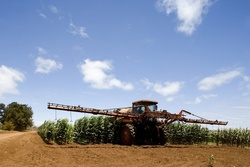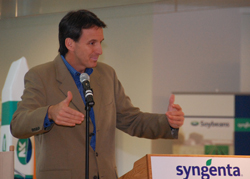 For those of you who want to analyze everything that passes your lips USDA has a new web page that will give you the details on any food products.
For those of you who want to analyze everything that passes your lips USDA has a new web page that will give you the details on any food products.
MyFood-a-pedia – The much anticipated MyFood-a-pedia is a new online tool that gives consumers quick access to nutrition information for over 1,000 foods. The MyFood-a-pedia provides calorie count information on the contribution of the food to the five food groups people need to be healthy. MyFood-a-pedia, located at www.MyFoodapedia.gov, also provides the number of “extra” calories in foods from solid fats, added sugars, and alcohol.
I’m sure this will help some people but it just kind of takes some of the taste out of food for me. Just for the record, I was not anticipating this.
Syngenta Seed Breeders in Paradise
 Why is this man smiling? Probably because he spends about half the year in Hawaii working on new corn seed hybrids for growers to plant back here on the mainland.
Why is this man smiling? Probably because he spends about half the year in Hawaii working on new corn seed hybrids for growers to plant back here on the mainland.
Ben Hable (pronounced Hobbly) is Syngenta Seeds Corn Product Development Lead. During an agricultural media seminar following the grand opening of the new Syngenta Seeds headquarters in Minnetonka, MN this week, Ben said that producing seed corn in Hawaii allows them to fast track new products to market. “In Hawaii we can actually turn a crop every 3 and a half months so we can increase the seeds that we need to get back here to the mainland for seed production,” Ben told me during an interview. “Syngenta now has over 300 full time staff in the state of Hawaii working on corn and soybean seed production.”
 Ben told us that seed corn is now Hawaii’s biggest cash crop, and he was telling the truth. Just today, a story came out of Honolulu about the latest report from the the Hawaii Field Office of USDA’s National Agricultural Statistics Service (NASS) that says the value of Hawaii’s seed industry for the 2008/2009 season was a “record high” of $176.6 million. Seed corn accounts for $169.3 million, or 96 percent, of the total value.
Ben told us that seed corn is now Hawaii’s biggest cash crop, and he was telling the truth. Just today, a story came out of Honolulu about the latest report from the the Hawaii Field Office of USDA’s National Agricultural Statistics Service (NASS) that says the value of Hawaii’s seed industry for the 2008/2009 season was a “record high” of $176.6 million. Seed corn accounts for $169.3 million, or 96 percent, of the total value.
A recent Hawaii Farm Bureau Federation study shows that seed crops have become the largest agricultural commodity in the state, exceeding the value of both sugar and pineapple by 180 percent and 90 percent, respectively. The photo is of seed corn growing on the island of Molokai.
Listen to or download my interview with Ben Hable below.
Sponsored by 
FuelChat Session at 2pm Eastern Today
 This is a reminder that today at 2:00pm Eastern time the Renewable Fuels Association will be hosting another 1 hour online Twitter chat session. It’s FuelChat and you will have the chance to ask questions and interact with others on the subject of ethanol. I’ll be working with RFA as moderator for today’s session.
This is a reminder that today at 2:00pm Eastern time the Renewable Fuels Association will be hosting another 1 hour online Twitter chat session. It’s FuelChat and you will have the chance to ask questions and interact with others on the subject of ethanol. I’ll be working with RFA as moderator for today’s session.
There are a number of mechanisms you can use to follow along and participate. We recommend TweetChat. Just go to TweetChat.com, log in with your Twitter account login and then enter the search term, #fuelchat. TweetChat will display a live list of Twitter posts that use the #fuelchat “hashtag” and you can read them, reply to them or enter your own. Another useful mechanism is Twitterfall.
If you’ve never used Twitter and don’t have a free account, you can still go to Search.Twitter.com and search for #fuelchat to see the results. You will need to manually refresh the page to see new ones as they are posted. It’s also a good way to go back and review the session afterward.
Post Update: Today’s FuelChat session has concluded and as a reminder you can see the questions/answers/comments by reviewing all the posts using this link.
Zimfo Bytes
- Members of the Missouri Renewable Fuels Association have selected Ryland Utlaut of Alma, Mo., as the organization’s 2009-10 president.
- New Optimize 400 with LCO Promoter Technology delivers new treatability benefits for retailers and extraordinary ROI for growers.
- Vermeer Corporation offers a new carted wheel rake, called the VR-Series. It is available in 8 and 10 wheel sizes.
- Cibus is now Cibus Global. The shift marks a new age for the company, with an international operating structure and a continued focus on advancement and product growth in markets around the globe.

BASF Kixor Gets Results
 We were happy to see BASF finally get Environmental Protection Agency (EPA) registration for Kixor® herbicide last week for use on a wide range of crops and effective on more than 70 broadleaf weeds.
We were happy to see BASF finally get Environmental Protection Agency (EPA) registration for Kixor® herbicide last week for use on a wide range of crops and effective on more than 70 broadleaf weeds.
Four formulations “powered by Kixor” are now available for growers — Sharpen™ herbicide for various crops, OpTill™ herbicide for soybeans, Integrity™ herbicide for corn and Treevix™ herbicide for citrus, fruit and tree nuts. To get an idea of how effective this new chemistry is on broadleaf weeds, BASF had a plot tour demonstration for growers to check out at the 2009 Farm Progress Show. Take a look here:
Hot Potato Ideas
 The U.S. Potato Board held a “Hot Potato Ideas” contest and culinary students were rewarded for their innovative recipes like this Cheesy Southwestern Potato Crisps one shown in the photo. During my pheasant hunt our cook made us some of the best potato pancakes I’ve ever eaten. Perhaps we should get her to enter next time.
The U.S. Potato Board held a “Hot Potato Ideas” contest and culinary students were rewarded for their innovative recipes like this Cheesy Southwestern Potato Crisps one shown in the photo. During my pheasant hunt our cook made us some of the best potato pancakes I’ve ever eaten. Perhaps we should get her to enter next time.
Creative ideas and innovation bring excitement to menus and inspire the restaurant patrons who enjoy them. This was the motivation behind the United States Potato Board’s (USPB’s) “Hot Potato Ideas” contest, which rewarded culinary students for their innovative potato recipes in one of three categories: Ethnic, Healthy and New Classics.
Twenty-two students from the Culinary Institute of America, Hyde Park, NY, campus entered the contest, so deciding upon the top three entries was a challenge. Nonetheless, here is a snapshot of the winning potato recipes:
Cheesy Southwestern Potato Crisps, a Latin-inspired recipe with fresh jalapeño-cilantro pesto and cheese enveloped in crisp shredded potatoes, captured the Ethnic Category and overall Grand Prize in the Potato Innovation Recipe Contest. This fresh and flavorful recipe was created by William “Trey” Smith. The USPB awarded Smith a trip to the Culinary Institute of America’s Worlds of Flavors® conference in St. Helena, CA, (Napa Valley) taking place November 12-14, 2009. Read More
Boehringer Ingelheim to Get Some of Ft. Dodge Animal Health
Later this year, Pfizer is merging with Wyeth Pharmaceutical, which owns Fort Dodge Animal Health. After the merger, Boehringer Ingelheim will acquire some of the Ft. Dodge assets from Pfizer. That’s the short version.
 According to the official announcement, Boehringer Ingelheim has entered into an agreement with Pfizer “to acquire certain assets of Wyeth Pharmaceutical’s Fort Dodge Animal Health business upon the closing of the global Pfizer-Wyeth merger, which is expected to occur early in the fourth quarter. The deal, which is subject to anti-trust clearance, significantly increases the size of Boehringer Ingelheim’s companion animal and cattle portfolios.”
According to the official announcement, Boehringer Ingelheim has entered into an agreement with Pfizer “to acquire certain assets of Wyeth Pharmaceutical’s Fort Dodge Animal Health business upon the closing of the global Pfizer-Wyeth merger, which is expected to occur early in the fourth quarter. The deal, which is subject to anti-trust clearance, significantly increases the size of Boehringer Ingelheim’s companion animal and cattle portfolios.”
If approved, the deal would clear the way for Boehringer Ingelheim to acquire a significant portion of the Fort Dodge product portfolio in several countries, as well as manufacturing and research facilities located in Fort Dodge, Iowa. In the U.S. and Canada Boehringer Ingelheim will own and market the pet and cattle vaccine lines as well as a wide range of pharmaceuticals for pets, cattle and other species. In Canada, several swine vaccines are also part of the package. In Australia, Boehringer Ingelheim will own and market the Fort Dodge pet vaccines and in some European countries and in South Africa, certain cattle vaccines.
BASF and Monsanto Team for Cotton Fungicide Seed Treatment
 BASF has announced a supply agreement with Monsanto for a new cotton fungicide seed treatment.
BASF has announced a supply agreement with Monsanto for a new cotton fungicide seed treatment.
 The new product contains F500®, the same active ingredient found in Headline® fungicide, BASF’s top-selling Plant Health fungicide, and will be part of Monsanto’s AcceleronTM Seed Treatment combination.
The new product contains F500®, the same active ingredient found in Headline® fungicide, BASF’s top-selling Plant Health fungicide, and will be part of Monsanto’s AcceleronTM Seed Treatment combination.
This new seed treatment will provide cotton growers with the opportunity to give seedlings a stronger start and a higher yield potential by controlling diseases, such as those caused by Rhizoctonia solani.
BASF is expanding its portfolio of seed treatment offerings with the launch of F500-containing products like Stamina® fungicide seed treatment, which is marketed for corn, sweet corn, wheat, barley, legumes, and rye. Several additional new seed treatments will be launched this year, and in 2010.
Syngenta CEO at New Seeds HQ
Syngenta Seeds Headquarters Opening Photo Album
 The CEO of Switzerland-based Syngenta helped to do the honors of opening the new headquarters of Syngenta Seeds in Minnetonka, MN on Monday.
The CEO of Switzerland-based Syngenta helped to do the honors of opening the new headquarters of Syngenta Seeds in Minnetonka, MN on Monday.
Mike Mack says the new building represents Syngenta planting the seeds of the future. “We’re really proud of this extraordinary building which embodies the forward-looking, sustainable qualities and spirit of innovation that have driven Syngenta and its predecessor companies for more than a century,” Mack said during the grand opening ceremony. Mack highlighted the features of the Leadership in Energy and Environmental Design (LEED) Gold certified building, which include natural light, recycled materials, and other environmentally-friendly features.
Mack also talked about how Syngenta Seeds was built on the acquisitions of several well-known seed brands, leading with Northrup King, which was started in Minnesota 125 years ago.
Listen to Mike Mack’s remarks at the grand opening below.
Sponsored by 
Minnesota Governor Congratulates Syngenta Seeds
 The beautiful start to the Syngenta Seeds grand opening celebration gave way to cloudy skies and a rain shower just as Governor Tim Pawlenty was to arrive, which meant a quick change in venue to inside the building. But, the weather change did nothing to dampen the spirits of everyone on hand and the governor was warmly welcomed by Syngenta Seeds President David Morgan and Syngenta CEO Mike Mack.
The beautiful start to the Syngenta Seeds grand opening celebration gave way to cloudy skies and a rain shower just as Governor Tim Pawlenty was to arrive, which meant a quick change in venue to inside the building. But, the weather change did nothing to dampen the spirits of everyone on hand and the governor was warmly welcomed by Syngenta Seeds President David Morgan and Syngenta CEO Mike Mack.
 Governor Pawlenty was pleased to congratulate Syngenta Seeds on the new headquarters building and their continued commitment to agriculture. “They’re not making land anymore, so there’s a finite amount of land,” said Pawlenty. “That’s why it’s imperative that we find a way to continue to feed the world and Syngenta is on the cutting edge of that technology.”
Governor Pawlenty was pleased to congratulate Syngenta Seeds on the new headquarters building and their continued commitment to agriculture. “They’re not making land anymore, so there’s a finite amount of land,” said Pawlenty. “That’s why it’s imperative that we find a way to continue to feed the world and Syngenta is on the cutting edge of that technology.”
The governor noted that he was very proud of Minnesota agriculture and the fact that one out of every seven jobs in the state is related to agriculture. “We can’t have a successful state without a successful agriculture,” said Pawlenty.
Syngenta Seeds Headquarters Opening Photo Album
Listen to or download the governor’s remarks below.
Sponsored by 
